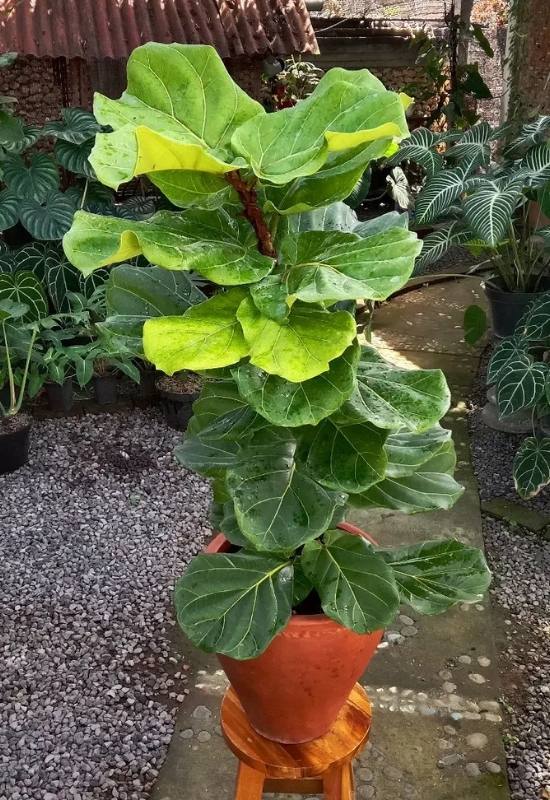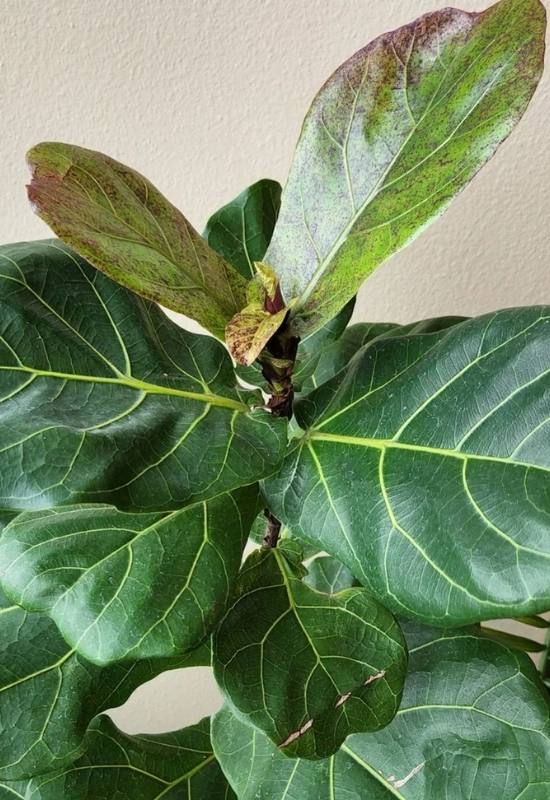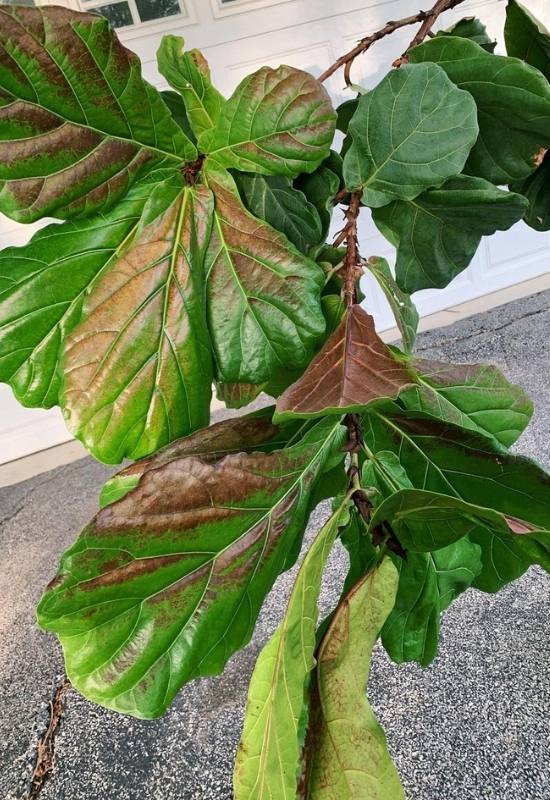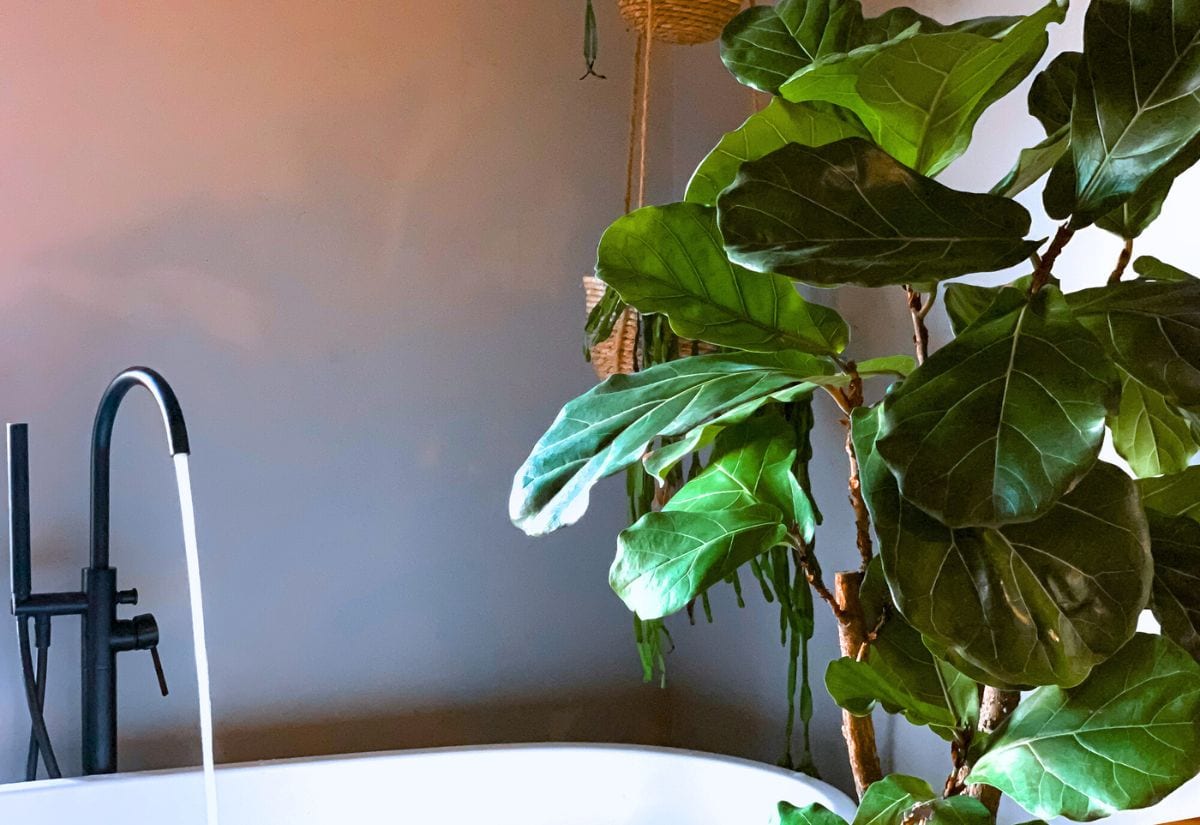
Fiddle leaf fig trees are all the rage right now, and it’s easy to see why! With their large, glossy leaves, these eye-catching tall houseplants add a touch of the tropics to any space.
Originating from the tropical regions of Africa, these beauties love warm temperatures and high humidity. When grown indoors, Ficus lyrata can even reach heights of 6-10 feet (1.8-3 meters)!
Caring for fiddle leaf figs might seem like a breeze, but watering them just right can be a bit of a challenge.
Yup, it’s something many of us plant lovers struggle to get just right.
Overwatering? Root rot is lurking. Underwatering? Say hello to brown leaves and sad, droopy upper leaves.
So, how do you know when, how often, and how much water your plant needs?
Imagine the fiddle leaf fig’s natural rainforest habitat, which consists of a significant downpour followed by a dry spell lasting a couple of weeks.
While it’s hard to give an exact amount of water for your fiddle leaf fig, as it depends on the plant and pot size, a good rule of thumb is to water it about once a week or every 10 days. Allow the top 3 to 6 inches of soil to dry out between watering sessions. When it’s time to quench your plant’s thirst, make sure to drench the soil thoroughly until it drains from the pot’s bottom. Then, let it drain completely.
Oh, and a quick heads-up: try not to get water on the leaves, as that can cause issues like leaf spot.
Keep in mind that your plant’s watering frequency depends on factors like light, temperature, humidity, and size.
By following these tips, you’ll master the art of watering your fiddle leaf fig, learn the best type of water to use, and understand the consequences of under or overwatering these stunning plants.
The Million-Dollar Question: How Often Should You Water Your Fiddle Leaf Fig?
Keep your Fiddle Leaf Fig’s root ball moderately moist but never too wet. To achieve this, water your plant as often as it takes for the top 3-6 inches of soil to dry out. Generally, water your Fiddle Leaf Fig every 7-10 days. However, during the dormant winter period, decrease the watering frequency to once every 2-3 weeks.
It’s important to remember that there isn’t a one-size-fits-all answer like “water every other week” or “once a month,” as the “how often” part is influenced by many factors. While you can use the general timeline mentioned above as a starting point, the real question you should ask is, “How do I know when to water my Fiddle Leaf Fig?”
If you notice your fiddle leaf fig has leaves turning brown or dropping off, this is usually a sign of underwatering. Increase the frequency of watering and be sure to water thoroughly, until water runs out of the bottom of the pot.
Remember, it’s always better to underwater than overwater. If you’re not sure whether your plant needs water, wait an extra day or two before watering.
How Long Can My Fiddle Leaf Fig Go Without Water
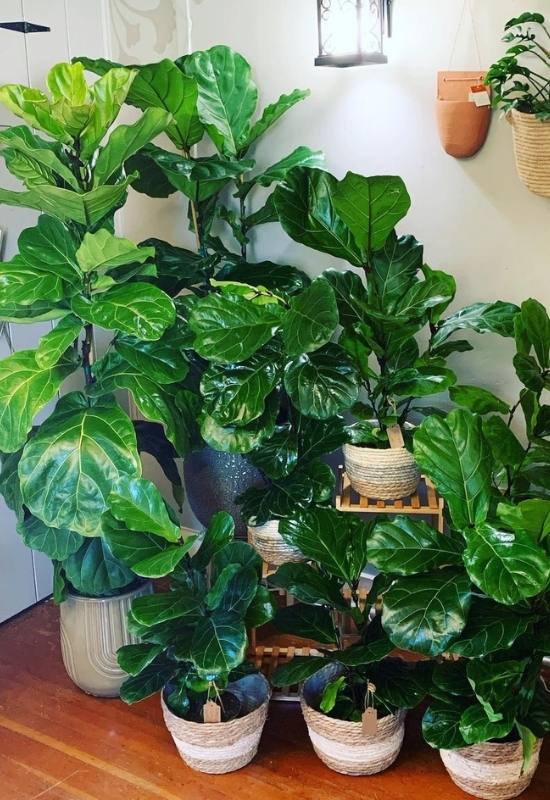
Generally, fiddle leaf figs can go about two weeks without any water. However, push it any longer and you risk leaving your green friend high and dry. The golden rule for your indoor fiddle leaf fig is to water it when the soil dries out, which usually happens every one to two weeks.
Now, let’s talk about those curveballs. Sometimes your fiddle leaf fig might need a little extra TLC.
If those gorgeous leaves start to droop or the soil feels dry, it’s their way of saying, “Hey, I need a drink!” On the other hand, if you spot yellowing or falling leaves, hold up! Your plant is probably telling you it’s had enough H2O for now.
The key is to stick to a regular watering schedule and then tweak it slightly depending on the season and light exposure.
How Does Light and Season Affect the Amount of Water?
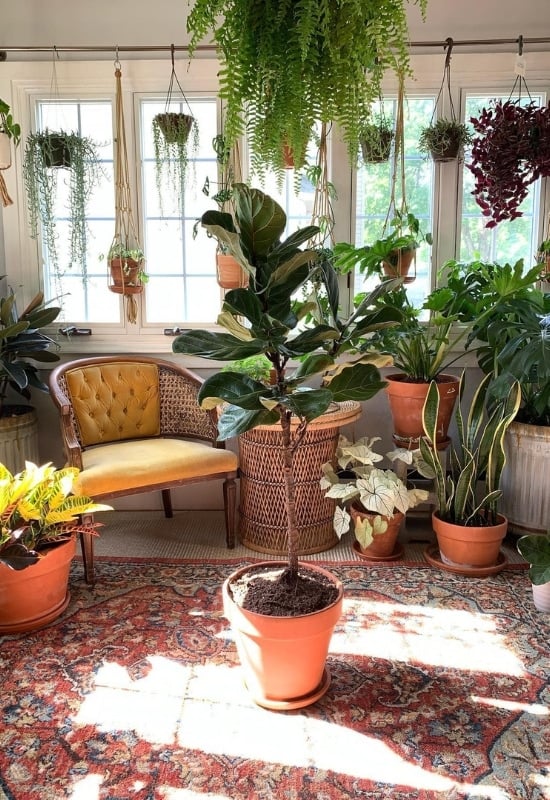
The amount of water a fiddle leaf fig needs depends on several factors, including the amount of light it receives and the time of year.
In general, these plants prefer bright, indirect sunlight and should be watered when the top inch of soil is dry. However, during the winter months, fiddle leaf figs will need less water as they enter a period of dormancy.
If the plant is receiving too much or too little light, it may also begin to drop its leaves, which is a sign that it needs to be watered more or less frequently. By paying close attention to these cues, you can ensure that your fiddle leaf fig always has the right amount of water.
What Happens if I Overwater my Fiddle Leaf?
Overwatering is the most common cause of problems with a fiddle leaf fig plant. When these plants are overwatered, the roots begin to rot, which can eventually kill the plant. Symptoms of overwatering include yellow or brown leaves, wilting, and leaf drop.
If the leaves are yellowing or wilting, this is a sign of overwatering. Allow the top inch or so of soil to dry out completely before watering again.
You may also need to adjust the type of potting mix you are using, as some mixes retain too much water and can lead to problems with overwatering.
If you think you’ve overwatered your fiddle leaf fig plant, stop watering immediately and allow the plant to dry out completely. Once the soil is dry, start watering again using the method described above.
If you continue to have problems with overwatering, try watering with distilled or rainwater instead of tap water. This will help to prevent mineral buildup in the soil, which can make it difficult for the plant to absorb water.
The Dangers of Underwatering Your Fiddle Leaf Fig
While overwatering is the most common problem with fiddle leaf fig plants, underwatering can also cause problems. When these plants are underwatered, the leaves will begin to turn brown and drop off. The plant may also stop growing.
If you think you’ve underwater your fiddle leaf fig, start watering more frequently, using the method described above. Water the plant until runoff appears, then wait 30 minutes before checking the moisture level of the soil again.
If you continue to have problems with under watering, try using a water-soluble fertilizer. This will help the plant to absorb water more easily.
To Water or Not to Water? How to Tell When Your Fiddle Leaf Fig Needs a Drink
There are a few signs that your fiddle leaf fig is telling you it needs watering:
If you see any of these signs, water your plant immediately. Wilting leaves can be a sign of both underwatering and overwatering, so make sure to check the moisture level of the soil before adding water.
Brown leaves are usually a sign of underwatering, while excessive leaf drop can be caused by either too much or too little water.
To ensure you’re watering your plant at the right time, you need to learn how to test the soil moisture and confirm that it’s dry before watering again.
So, how can you determine when the soil is dry and your plant is ready for a drink? Here are a few techniques:
Here’s how to check that soil moisture:
Soggy Soil, Sick Plant: The Link Between Overwatering and Fiddle Leaf Fig Diseases
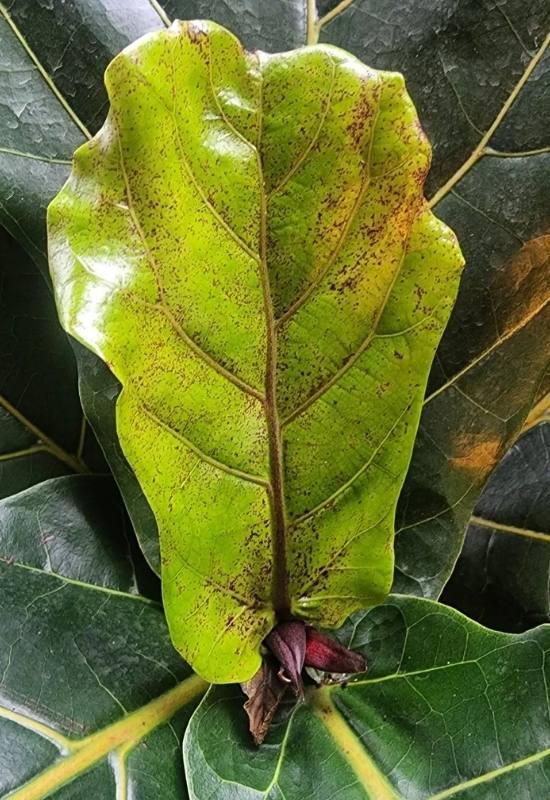
Fiddle leaf figs are relatively resistant to pests and diseases, but there are a few that can cause problems. Fiddle leaf fig watering can lead to a number of diseases and make your plant’s soil and leaves more susceptible to pests.
Overwatering can lead to root rot, a condition caused by waterlogged soil and too little drainage. Root rot can be fatal to your plant, so it’s important to make sure you’re not watering too frequently.
If you think your plant has root rot, stop watering for a week or two and let the soil dry out completely. You may also need to repot your plant into fresh, dry soil.
Underwatering can cause the leaves to turn brown or develop brown spots and drop off. This is usually a temporary condition, and the leaves will grow back once you start watering properly again.
However, if the roots are damaged from prolonged drought, they may not be able to recover. In this case, you may need to start with a new plant.
Fiddle leaf figs are susceptible to scale, mealybugs, and spider mites. These pests can cause the leaves to turn yellow or brown, and they can weaken the plant. If you see any pests on your plant, remove them by hand or treat with an insecticide labeled for use on fiddle leaf figs.
Leaf spot is a common disease that affects the fiddle leaf fig. It’s characterized by small brown or black spots on the leaves, which can eventually lead to leaf drop.
To prevent leaf spot, water early in the day so the leaves have time to dry before nightfall. Avoid getting water on the leaves, and avoid overhead watering if possible. If your plant does get leaf spot, treat with a fungicide labeled for use on fiddle leaf figs.
How to Water Your Fiddle Leaf Fig Plant Like a Pro
Fiddle leaf figs require a lot of water and humidity to thrive, so it is important to provide them with both on a regular basis. Here are some tips on how to water your FLF:
What is The Best Water For My Fiddle Leaf?
Fiddle leaf fig plants prefer filtered or distilled water, as the chemicals in tap water can build up and damage the leaves. If you can’t use filtered or distilled water, let your tap water sit for 24 hours before using it on your plant. This will allow some of the chemicals to dissipate.
In general, it’s best to use rainwater or distilled water for your plants, as these have a neutral pH and don’t contain any chemicals. You can also use bottled water, although this can be expensive.
You should also avoid using sparkling water or water that has been treated with a water softener, as these can also damage the leaves.
The ideal water temperature for a fiddle leaf fig is between 68-86 degrees Fahrenheit (20-30 degrees Celsius). If your tap water is too cold, let it sit out until it reaches room temperature water before using it on your plant.
Should I Mist My Fiddle Leaf Fig?
A Fiddle leaf fig’s soil should be kept evenly moist, but not soggy. Many people choose to mist their fiddle leaves in addition to watering them, as the extra humidity can be beneficial to the plant.
Misting also helps to prevent the leaves from becoming too dry and crispy. However, it is important not to mist the leaves if they are already wet, as t his can encourage fungal growth.
Overall, whether or not to mist a fiddle leaf fig is a personal preference. Some people find that their plants do well with regular misting, while others only mist occasionally or not at all. Just follow the rules, and there is no reason why you can’t!
Don’t Let Your Fiddle Leaf Fig Dry Out
Fiddle leaf figs are beautiful plants that make a great addition to any home. But before you can enjoy their beauty, you need to learn how to care for them properly.
Watering, fertilizing, and propagating are all important aspects of fiddle leaf fig care. By following the tips we’ve presented, you’ll be sure to keep your plant healthy and happy.
Fiddle leaf figs are relatively easy to care for plants, but proper watering is essential to keeping them healthy and happy. Allow the top inch of soil to dry out between watering, and water thoroughly, until water runs out of the bottom of the pot or through the drainage hole.
Avoid getting water on the leaves, and be sure to reduce watering during the winter months. If you notice any problems with the leaves, such as browning or wilting, adjust your watering schedule accordingly. With a little care, your fiddle leaf fig will thrive for years to come.

Written By
Emily O Bethke
Born in northern Wisconsin, Emily has always had a passion for plants. This passion has led her to work in greenhouses, landscaping, and academic plant research at multiple university’s. She graduated from the University of Wisconsin Milwaukee with a BS in conservation and environmental science. When she isn’t caring for her plants or writing you can find her traveling, cooking, at live music shows, and spending time in nature.

